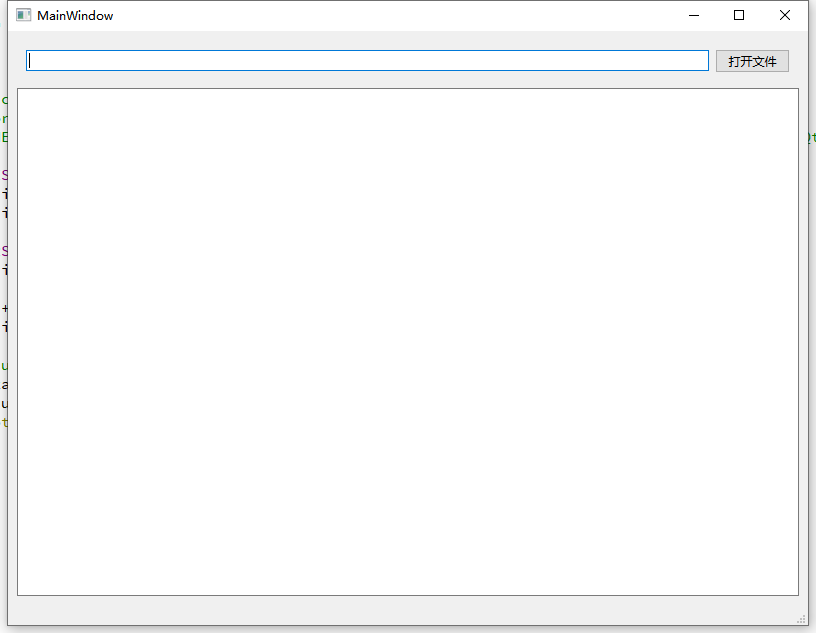
QT-文件
界面

使用到的组件
- QLineEdit
- QPushButton
- QPlainTextEdit
实现功能
- 打开文件实现QLineEdit中显示文件地址
- QPlainTextEdit中显示文件内容
代码
读取文件
读取文件的所有内容
void MainWindow::on_pushButton_clicked()
{
QString filename = QFileDialog::getOpenFileName(this, "打开一个txt文件", "","TXT (*.txt)");
qDebug() << "filename: " << filename;
// 判断文件名是否为空,为空直接退出
if(filename.isEmpty())
{
return;
}
this->ui->lineEdit->setText(filename);
// 使用QFile读取文件
// 打开文件
QFile file(filename);
file.open(QIODevice::ReadOnly);
QByteArray byteArr = file.readAll();
// 将QByteArray转化成QString
QString content = byteArr;
// 如果需要编码
// QTextCodec *codec = QTextCodec::codecForName("gbk");
// QString content = codec->toUnicode(byteArr);
// 输出到edit上
ui->plainTextEdit->setPlainText(content);
// 关闭文件
file.close();
}按行读取文件内容
void MainWindow::on_pushButton_clicked()
{
QString filename = QFileDialog::getOpenFileName(this, "打开一个txt文件", "","TXT (*.txt)");
qDebug() << "filename: " << filename;
// 判断文件名是否为空,为空直接退出
if(filename.isEmpty())
{
return;
}
this->ui->lineEdit->setText(filename);
// 使用QFile读取文件
// 打开文件
QFile file(filename);
file.open(QIODevice::ReadOnly);
QByteArray byteArr;
do
{
// 单行读取
byteArr += file.readLine();
} while (!file.atEnd());
// 将QByteArray转化成QString
QString content = byteArr;
// 输出到edit上
ui->plainTextEdit->setPlainText(content);
file.close();
}写入文件
QFile file("D:\\test001.txt");
file.open(QIODevice::WriteOnly|QIODevice::Append);
file.write("喝了咯");
file.close();
| Constant | Value | Description |
|---|---|---|
| QIODeviceBase::NotOpen | 0x0000 | The device is not open. |
| QIODeviceBase::ReadOnly | 0x0001 | The device is open for reading. |
| QIODeviceBase::WriteOnly | 0x0002 | The device is open for writing. Note that, for file-system subclasses (e.g. QFile), this mode implies Truncate unless combined with ReadOnly, Append or NewOnly. |
| QIODeviceBase::ReadWrite | ReadOnly | WriteOnly | The device is open for reading and writing. |
| QIODeviceBase::Append | 0x0004 | The device is opened in append mode so that all data is written to the end of the file. |
| QIODeviceBase::Truncate | 0x0008 | If possible, the device is truncated before it is opened. All earlier contents of the device are lost. |
| QIODeviceBase::Text | 0x0010 | When reading, the end-of-line terminators are translated to ‘\n’. When writing, the end-of-line terminators are translated to the local encoding, for example ‘\r\n’ for Win32. |
| QIODeviceBase::Unbuffered | 0x0020 | Any buffer in the device is bypassed. |
| QIODeviceBase::NewOnly | 0x0040 | Fail if the file to be opened already exists. Create and open the file only if it does not exist. There is a guarantee from the operating system that you are the only one creating and opening the file. Note that this mode implies WriteOnly, and combining it with ReadWrite is allowed. This flag currently only affects QFile. Other classes might use this flag in the future, but until then using this flag with any classes other than QFile may result in undefined behavior. (since Qt 5.11) |
| QIODeviceBase::ExistingOnly | 0x0080 | Fail if the file to be opened does not exist. This flag must be specified alongside ReadOnly, WriteOnly, or ReadWrite. Note that using this flag with ReadOnly alone is redundant, as ReadOnly already fails when the file does not exist. This flag currently only affects QFile. Other classes might use this flag in the future, but until then using this flag with any classes other than QFile may result in undefined behavior. (since Qt 5.11) |
摘选自:https://doc.qt.io/qt-6/qiodevicebase.html#OpenModeFlag-enum
© 版权声明
文章版权归作者所有,未经允许请勿转载。
相关文章

暂无评论...


